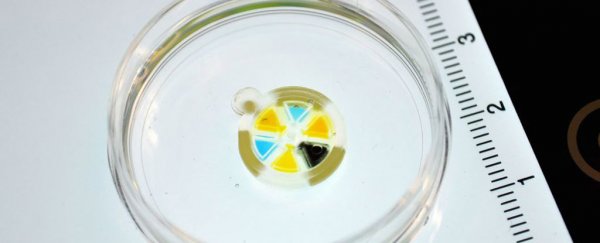Scientists have developed a bio-compatible micro-machine capable of being implanted inside the body, where it could act as a wireless medical device to deliver drugs directly under the skin.
The device, which measures only 15 millimetres long, is actually a squishy version of a mechanism called a Geneva drive, which has been used in wristwatches going as far back as the 17th century. Only this time, it would be worn inside and not outside the body.
Most of today's implanted medical aids are made from static components that don't allow freely moving parts. And because they often include batteries or other kinds of electronics that are toxic to the body, they can create complications with the human tissue that surrounds them.
Of course, devices such as pacemakers have been successfully implanted in patients for decades, but compared to inflexible, metallic devices, researchers think soft, supple implants could make a range of new medical treatments possible in the future.
"Traditional implantable devices are made of silicon or metal, and there are certain manufacturing processes that you would use to make devices out of those materials," researcher Samuel Sia from Columbia University told Abby Olena at The Scientist.
"But they don't work on biological materials, which are much softer, and so we had to develop our own methods."
To develop an implant with moving parts that could be safely implanted inside the body, the team turned to hydrogels – a material composed of polymer chains with high water content (over 90 percent), which makes it soft, flexible, and highly compatible with biological tissue.
Using a method to stack layered sheets of this hydrogel, the researchers can fabricate their squishy Geneva drive in about 30 minutes – but developing the technique and discovering the right materials to use took some eight years of research.
The team ultimately decided on polyethylene glycol (PEG)–based hydrogels, which are biodegradable and approved by the FDA for use in medical devices.
"Of course, you have other devices that are also made out of bio-compatible materials, but those are mostly passive devices," researcher Albert van den Berg from the University of Twente in the Netherlands, who was not involved in the study, told The Scientist.
"[T]hese are active, command-able devices. It's really a breakthrough."
The team calls their squishy Geneva drive "implantable microelectromechanical systems" (iMEMS), and you can see how it works in the video below:
A magnet outside the device rotates a small driving gear in the implant.
Each full revolution of the small gear rotates a larger gear by 60 degrees, exposing one of six potential drug reservoirs to an aperture, through which medication can be released to the body.
While the device isn't a fully independent micro-robot, capable of acting on its own, it is a machine that can perform its function inside the body without any direct physical contact with the outside world – save the nearby presence of a single magnet.
In testing with mice bred to develop bone cancer (osteosarcoma), the researchers magnetically triggered the release of the chemotherapy medication doxorubicin over the course of 10 days.
The results showed that using the device with just 10 percent of a regular doxorubicin dosage was more effective in stopping tumour growth and killing cancer cells than conventional chemotherapy – with a 56 percent reduction in cancer cells for iMEMS, compared with 39 and 19 percent reductions for high- and low-dosage systemic treatments respectively.
The device was also less toxic to the subject overall than a conventional treatment, since such a reduced amount of chemotherapy medication was released.
While it's early days for the technology as a whole, and these promising results have only been seen in mice so far, the researchers hope that one day their micro-machines could be used to deliver cancer-fighting medications in humans – or other kinds of drugs we need, like insulin.
"People are already making replacement tissues and now we can make small implantable devices, sensors, or robots that we can talk to wirelessly," Sia said in a press release.
"Our iMEMS system could bring the field a step closer to developing soft miniaturised robots that can safely interact with humans and other living systems."
The findings are reported in Science Robotics.
